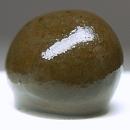|
|
||||||||||||||||
|
||||||||||||||||
|
||||||
|
|
|
|
Buserite
|
|
| | |
| Discovered in 1970; IMA status: Not Valid (IMA Not Approved yet) | ||
|
| ||
|
Chemistry |
|
|
| |
|
Na4Mn14O2 • 21(H2O) | |
|
|
Hydrated Sodium Manganese Oxide |
|
|
|
|
Classification |
|
|
| |
|
Oxides | |
|
4/F.11-30 | |
|
|
4 : OXIDES (Hydroxides, V[5,6] vanadates, arsenites, antimonites, bismuthites, sulfites, selenites, tellurites, iodates)
|
|
Related to: |
Dehydrates to Birnessite. Closely related to Todorokite. |
|
Varieties: |
None |
|
Synonyms: |
IMA 1970-024 |
|
|
|
|
Occurances |
|
|
|
|
|
Geological Setting: |
Stream beds; hot spring deposits; deposits from rhodochrosite mine wastewater; also in deep sea manganese nodules |
|
Common Associations: |
Rancieite |
|
Common Impurities: |
n/a |
|
Type Locality: |
Yuno-Taki waterfall, Me-akan volcano, Akan National Park, Kushiro Province, Hokkaido Island, Japan |
|
Year Discovered: |
1970 |
|
View mineral photos: | |
|
|
|
|
More Information |
|
|
|
|
|
| |
|
|
|
|
Locations
for Buserite: the type locality at the Yuno-Taki waterfall, Me-akan volcano, Akan National Park, Kushiro Province, Hokkaido Island, Japan.
Also in Japan at the Oppu Mine, Aomori, Honshu Island.
In Austria at the Bürgergilde marble
quarries, Olsa, Friesach - Hüttenberg area, Carinthia.
In Korea at the Janggun and Dongnam Mines. In Moldova
at the Emil Racovita Cave (Zoluska Cave), Criva, Edinet.
In the Ukraine on the Kerch Peninsula, Crimea Peninsula,
Crimea Oblast'. In the USA at Pinal Creek, Globe Placers,
Globe Hills District, Globe-Miami District, Gila County,
Arizona. |
|
|
We
have not photographed our Buserite
gems yet. Please
check back soon. |
